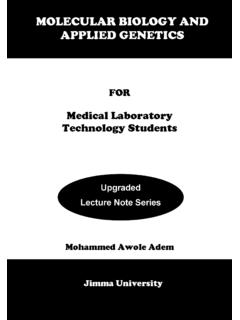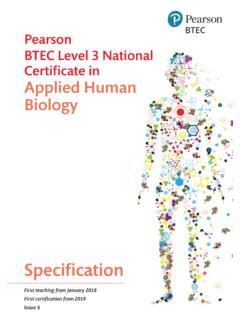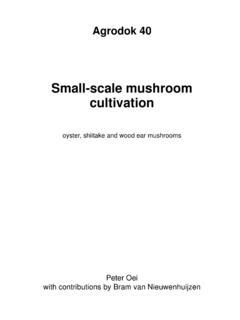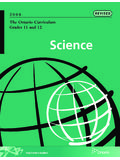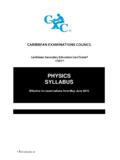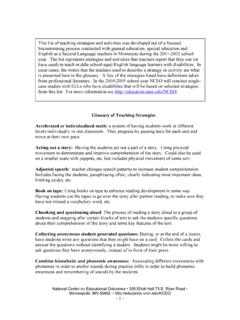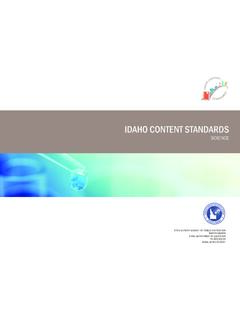Transcription of guidelines review article final - ETH Z
1 1 This resource was written 2009 by: Philip Mayer, Zurich-Basel Plant Science Center ( ) guidelines for writing a review article A) Good to know about review articles B) Elements of a review article C) guidelines for preparing a review article in 18 steps D) Examples of high-quality review articles in the plant sciences (to be used in your own work) E) References used in this Guideline A) Good to know about review articles What is a review article ? A critical, constructive analysis of the literature in a specific field through summary, classification, analysis, comparison. A scientific text relying on previously published literature or data. New data from the author s experiments are not presented (with exceptions: some reviews contain new data). A stand-alone publication. Literature reviews as integral parts of master theses, doctoral theses or grant proposals will not be considered here.
2 However, many tips in this guideline are transferable to these text types. What is the function of a review article ? to organize literature to evaluate literature to identify patterns and trends in the literature to synthesize literature to identify research gaps and recommend new research areas Who is the audience of review articles? experts in specific research areas students or novice researchers decision-makers review articles targeted at the last two groups: Extended explanations of subjects or of subject-specific language are mandatory ( through the uses of information boxes or glossaries). Which types of review articles exist? Types by methodological approach Narrative review Selected studies are compared and summarized on the basis of the author s experience, existing theories and models. Results are based on a qualitative rather than a quantitative level.
3 Best evidence review A focus on selected studies is combined with systematic methods of study-selection and result exploration. Systematic review Findings from various individual studies are analyzed statistically by strict procedures. Meta-Analyses are used to pool the results of individual studies. 2 Types by objective (Noguchi 2006) Status quo review Presentation of the most current research for a given topic or field of research. History review Development of a field of research over time. Issue review Investigation of an issue ( a point of disagreement or a question) in a specific field of research. Theory/model review Introduction of a new theory or model in a specific field of research. Types by mandate Invited reviews: experienced researchers are invited Commissioned reviews: formal contracts of authors with clients Unsolicited submissions: researchers develop an idea for a review and submit it to journal editors How long is a review article ?
4 review articles vary considerably in length. Narrative reviews may range between 8,000 and 40,000 words (references and everything else included). Systematic reviews are usually shorter with less than 10,000 words. B) Elements of a review article Title Function Helping readers to decide whether they should read the text or not. Includes terms for indexing ( in data bases). Elements The title must be informative: The title has to include important terms. It has to indicate that the text is a review article . It may include the message of the article , not just its coverage (Gustavii 2003). The title must be short: Keep the title concise. A longer subtitle may be an option in case a specification is necessary. Tense In a title with results indicated: the present tense stresses the general validity of the results and illustrates what the author is trying to achieve with the article ; the past tense indicates that results are not established knowledge yet.
5 Citations None Length between eight to 12 words (Davis 2005) Question The title should only be a question if this question remains unanswered at the time of writing. 3 List of authors Function Declare intellectual ownership of the work, provide contact information Elements 1) Decision on authorship: Every person that contributed significantly to the literature search, literature exploration and/or writing process. 2) Order of authors: The first author has done most of the research and written major parts of the article . Authors between first and last author have contributed in one way or the other to the success of the project. They may be ordered alphabetically (indicating equality) or in a sequence of decreasing involvement. The last author usually coordinated the project and had the original idea. IMPORTANT: Discuss authorship as early as possible!
6 Abstract Function Informs about the main objectives and result of the review article (informative abstract) or indicates the text structure (descriptive abstract). Descriptive abstract - for narrative reviews Elements Description of subjects covered without specific details. A descriptive abstract is like a table of contents in paragraph form. Tense present Informative abstract - for systematic and best evidence reviews Elements 1) Objectives: One or two sentences describe the context and intention of the review . 2) Material and methods: One or a few sentences provide a general picture of the methodological approach. 3) Results: A few sentences describe main outcomes. 4) Conclusions: One or two sentences present the conclusion (which is linked to the objectives). Tense objectives: present material and methods, results: past conclusions: present Citations usually none Length usually 200 to 250 words Table of Contents 4 Function Shows the readers the organisation of the text.
7 Helps orientation among sections. Note Some review journals print an outline/table of contents at the beginning of the article , others do not. In general, these are recommended for extensive narrative reviews. Introduction Function Provides information about the context, indicates the motivation for the review , defines the focus, the research question and explains the text structure. Elements Elements of a three paragraph introduction (after Anonymous 2003). 1) Subject background. The general topic, issue, or area of concern is given to illustrate the context. 2) Problem . Trends, new perspectives, gaps, conflicts, or a single problem is indicated. 3) Motivation/justification. The author s reason for reviewing the literature, the approach and the organisation of the text are described. Tense present (use past tense for the description of your methods and your results) Citations many Length Between 10% and 20% of the core text (introduction, body, conclusions).
8 Note Make sure to have a narrow focus and an explicit research question. Indicate these two points clearly in the introduction. Give theoretical or practical justifications for the need for a review . Body: Material and Methods Function Systematic and best evidence reviews have a methods section. This section enables motivated researches to repeat the review . Narrative reviews do not have a methods section but should include some information about applied methods at the end of the introduction. Elements The material and methods section contains for example information about: data sources ( bibliographic databases), search terms and search strategies, selection criteria (inclusion/exclusion of studies), the number of studies screened and the number of studies included, statistical methods of meta-analysis. 5 Tense past Citations few ( to statistical analyses or software used) Length Approx.
9 5% of the core text (introduction, body, conclusions). Note Make sure that data sources are clearly identified. Precision has first priority in the material and methods section. Body: Main Part of the review article Section structure A coherent structuring of the topic is necessary to develop the section structure (Bem 1995). Subheadings reflect the organisation of the topic and indicate the content of the various sections. Possible criteria for structuring the topic are: methodological approaches models or theories extent of support for a given thesis studies that agree with another versus studies that disagree chronological order geographical location Paragraph structure Cover one idea, aspect or topic per paragraph. Avoid referring to only one study per paragraph; consider several studies per paragraph instead. Links Frequently link the discussed research findings to the research question stated in the introduction.
10 These links create the a thread of coherence in your review article . Link the studies to one another. Compare and discuss these relationships. Tense According to Ridley (2008) three tenses are frequently used: Present: reporting what another author thinks, believes, writes, reporting current knowledge or information of general validity, It is Simple past: referring to what a specific researcher did or found, referring to a single study, They Present perfect: referring to an area of research with a number of independent researchers involved, They have 6 Citations Citations are usually indirect but in some cases pointed and relevant remarks might be cited directly. Non-integral references (indirect): The author s name, or a number referring to the reference list, appears in brackets. Non-integral references emphasize the idea, result, theory etc.
